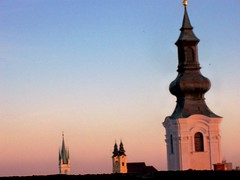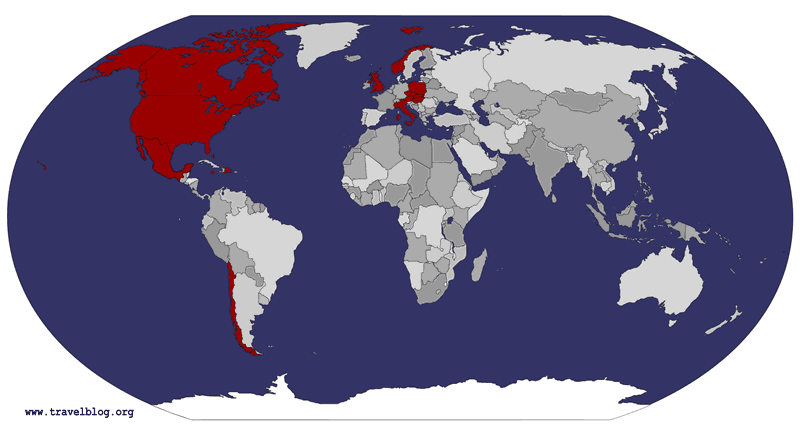Words with Feet
"And in every place she abandons she leaves something vital, it seems to me, and starts her new life somewhat less encrusted, like a lobster that has shed its skin and is for a time soft and vulnerable."
- E.B. White
Friday, February 09, 2007
Wednesday, January 31, 2007
Carmen Sandiego
I do exist, I promise.
Most recently, I've been existing in England, Norway, and Italy. And then on Sunday, I'm off to the Fulbright mid-year conference. So I've been a bit neglegent in my blogging lately. Sorry about that.
In the meantime, while I come up with a concise version of everything since Christmas, you can take a look at my travel pictures at http://community.webshots.com/user/serendipityjdg.
Here's a sample:
 (That's Stratford-upon-Avon)
(That's Stratford-upon-Avon) (Psychotically steep ski slope in Norway)
(Psychotically steep ski slope in Norway) (And the Ponte Vecchio)
(And the Ponte Vecchio)Monday, December 11, 2006
A Virtual Holiday Card
Made this for my family, since I won't be stateside for Christmas. Thought any friends in blogland might also enjoy it. (The first song is a traditional Slovak Christmas carol; the second is by Czech songwriter Jaromir Nehovica).
Thursday, December 07, 2006
'Tis the Season
One of my favorite essays by David Sedaris is a piece which illustrates the reality and fundamental humor of cultural differences. It's called "Six to Eight Black Men," so titled because in the Netherlands, Santa Claus is accompanied not by elves, but a band of former slaves. In the hundreds of years of Christmas lore, it seems that no one has taken the time to count these men, and so the Dutch speculate that Mr. Claus travels with roughly six to eight of them.
Sedaris spends the bulk of the text marveling at other, seemingly bizarre, Christmas tidbits from the Netherlands—nuggets of trivia depicting Santa Claus as an angular retired bishop of Turkey who now resides in Spain, and travels with his troops every winter to reward the good children. The bad ones go in his sack, to be either kicked by his six to eight counterparts or taken away from their homes.
I must thank Mr. Sedaris, because his prose provided me with an excellent transition into holiday chatter in the classroom. And, after reading about the somewhat violent manners of a Dutch Christmas, I was eager to learn what spending December in Slovakia might have in store for me.
First of all, Santa Claus is out of the equation. There is a specially designated "Saint Nicholas Day" on 6 December, but it's mainly for small children, and only involves the magical appearance of candy. For me, this meant the magical appearance of "Den a Noc" chocolates from Toney, and three giant foil wrapped candies from my adorable seminar class, which they'd placed on my desk before I entered the room. Traditionally, the children leave St. Nick their Christmas wish lists, which he is kind enough to deliver for them. (Because in Slovakia, children still hand-write their lists, rather than shooting an email to the North Pole like American kids now do).
"But wait a minute," I said. "If Saint Nicholas is bringing them candy, and there is no Slovak Santa—who exactly is he delivering these lists to?"
This is the point where, in America, the class would have slapped their palms to their foreheads and muttered "duh!" with that you're-so-out-of-the-loop inflection. However, being Slovak, my students just pointed a very large, very blank stare in my direction. Politely, of course.
"Come on," I prompted. "Who gives out the presents?"
"Little baby Jesus," answered a girl called Daniela, who stated the obvious by noting that Christmas is the day when Jesus was born. "He crawls through the window and fills your boots with presents."
Well, obviously. Because the kid doesn't have anything better to do on his own birthday.
We'd already read the Sedaris piece, so I ventured the question. "And he comes alone? No elves, no former slaves, no reindeer?" Mostly I was just curious as to how an infant could manage to carry that sack of gifts while he toddled his way around the world.
"He comes alone," volunteered Beata. "But on St. Nicholas Day, the angel and devil are with him."
This was demonstrated rather apparently yesterday, when people dressed as these characters trotted through the main square.
Of course, neither of these winter holidays hold a candle to what I can expect in the spring. Once we introduced Jesus as a character in this conversation, it was inevitable that we should also discuss Easter traditions. In Slovakia, though it is customary to dye and decorate eggs, there are no egg hunts or baskets of goodies, and the Easter Bunny has, erm, a slightly different meaning.
"So is there an Easter Bunny?" I asked. The students looked confused, so I described the American tradition of grown men in brightly colored bunny suits posing for pictures with children in shopping malls. They continued looking confused.
"Well," said Marta in a perfect deadpan, "Rabbit is part of Easter. But we don't take picture of them. We eat them."
Oh. How cute.
I asked if it seemed strange that American Easters involved such things—baskets, bunnies, egg hunts.
"Strange? No. Not really."
I figured this was because American media had trickled down to Slovak television stations, like the Simpsons, South Park, and Home Alone films already have. While this is true, the main reason American Easter doesn't seem weird to the Slovak population is because the Slovaks have their own bizarre ritual.
It seems that the Monday and Tuesday following Easter are bank holidays. On Monday, all the Slovak boys take buckets of water or bottles of what was consistently described as "very bad perfume" and hit the town, with a strong agenda to spray as many of their female friends as possible.
In a different class, I have two international students – a girl from Poland, and a girl from the Czech Republic – so I was able to get a second opinion on this as a universally Eastern European phenomenon. Poles rightfully believe this is an odd custom, and have nothing of the sort. The Czechs skip the very bad perfume and water buckets.
"But boys beat the girls," said the Czech girl. "On their asses. With hand or the tree branch." Lovely.
In recallinag this conversation to my handler, who's approximately my age and male, he affirmed that this is true of Slovakia as well. I must have been too caught up in the water-dumping and perfume-spraying to hear it from my class. The smirk on his face told me he'd done this many times, to many girls.
He added that sometimes the guys travel in groups, kidnap the girl, and dump her in a freezing swimming pool.
"We send the smallest guy to ring her doorbell, so she doesn't expect anything," Dušan explained. "Then, when she answers, we all grab her and carry her to the pool and throw her in."
"And what do the girls do for revenge?" The feminist in me hoped for some equally twisted payback, once the girls had all showered off the very bad perfume and dried themselves off from the pool. I imagined the Slovak women tying the men to trees, or dumping them in the Nitra River, or at the very least drenching them in very bad cologne.
"Oh, they can do it to the boys on the next day, but usually they don't. Really the only thing they can do is lock the door."
Let the holiday season begin….
Sedaris spends the bulk of the text marveling at other, seemingly bizarre, Christmas tidbits from the Netherlands—nuggets of trivia depicting Santa Claus as an angular retired bishop of Turkey who now resides in Spain, and travels with his troops every winter to reward the good children. The bad ones go in his sack, to be either kicked by his six to eight counterparts or taken away from their homes.
I must thank Mr. Sedaris, because his prose provided me with an excellent transition into holiday chatter in the classroom. And, after reading about the somewhat violent manners of a Dutch Christmas, I was eager to learn what spending December in Slovakia might have in store for me.
First of all, Santa Claus is out of the equation. There is a specially designated "Saint Nicholas Day" on 6 December, but it's mainly for small children, and only involves the magical appearance of candy. For me, this meant the magical appearance of "Den a Noc" chocolates from Toney, and three giant foil wrapped candies from my adorable seminar class, which they'd placed on my desk before I entered the room. Traditionally, the children leave St. Nick their Christmas wish lists, which he is kind enough to deliver for them. (Because in Slovakia, children still hand-write their lists, rather than shooting an email to the North Pole like American kids now do).
"But wait a minute," I said. "If Saint Nicholas is bringing them candy, and there is no Slovak Santa—who exactly is he delivering these lists to?"
This is the point where, in America, the class would have slapped their palms to their foreheads and muttered "duh!" with that you're-so-out-of-the-loop inflection. However, being Slovak, my students just pointed a very large, very blank stare in my direction. Politely, of course.
"Come on," I prompted. "Who gives out the presents?"
"Little baby Jesus," answered a girl called Daniela, who stated the obvious by noting that Christmas is the day when Jesus was born. "He crawls through the window and fills your boots with presents."
Well, obviously. Because the kid doesn't have anything better to do on his own birthday.
We'd already read the Sedaris piece, so I ventured the question. "And he comes alone? No elves, no former slaves, no reindeer?" Mostly I was just curious as to how an infant could manage to carry that sack of gifts while he toddled his way around the world.
"He comes alone," volunteered Beata. "But on St. Nicholas Day, the angel and devil are with him."
This was demonstrated rather apparently yesterday, when people dressed as these characters trotted through the main square.
Of course, neither of these winter holidays hold a candle to what I can expect in the spring. Once we introduced Jesus as a character in this conversation, it was inevitable that we should also discuss Easter traditions. In Slovakia, though it is customary to dye and decorate eggs, there are no egg hunts or baskets of goodies, and the Easter Bunny has, erm, a slightly different meaning.
"So is there an Easter Bunny?" I asked. The students looked confused, so I described the American tradition of grown men in brightly colored bunny suits posing for pictures with children in shopping malls. They continued looking confused.
"Well," said Marta in a perfect deadpan, "Rabbit is part of Easter. But we don't take picture of them. We eat them."
Oh. How cute.
I asked if it seemed strange that American Easters involved such things—baskets, bunnies, egg hunts.
"Strange? No. Not really."
I figured this was because American media had trickled down to Slovak television stations, like the Simpsons, South Park, and Home Alone films already have. While this is true, the main reason American Easter doesn't seem weird to the Slovak population is because the Slovaks have their own bizarre ritual.
It seems that the Monday and Tuesday following Easter are bank holidays. On Monday, all the Slovak boys take buckets of water or bottles of what was consistently described as "very bad perfume" and hit the town, with a strong agenda to spray as many of their female friends as possible.
In a different class, I have two international students – a girl from Poland, and a girl from the Czech Republic – so I was able to get a second opinion on this as a universally Eastern European phenomenon. Poles rightfully believe this is an odd custom, and have nothing of the sort. The Czechs skip the very bad perfume and water buckets.
"But boys beat the girls," said the Czech girl. "On their asses. With hand or the tree branch." Lovely.
In recallinag this conversation to my handler, who's approximately my age and male, he affirmed that this is true of Slovakia as well. I must have been too caught up in the water-dumping and perfume-spraying to hear it from my class. The smirk on his face told me he'd done this many times, to many girls.
He added that sometimes the guys travel in groups, kidnap the girl, and dump her in a freezing swimming pool.
"We send the smallest guy to ring her doorbell, so she doesn't expect anything," Dušan explained. "Then, when she answers, we all grab her and carry her to the pool and throw her in."
"And what do the girls do for revenge?" The feminist in me hoped for some equally twisted payback, once the girls had all showered off the very bad perfume and dried themselves off from the pool. I imagined the Slovak women tying the men to trees, or dumping them in the Nitra River, or at the very least drenching them in very bad cologne.
"Oh, they can do it to the boys on the next day, but usually they don't. Really the only thing they can do is lock the door."
Let the holiday season begin….
Monday, November 13, 2006
Beer, Putty, and French writers
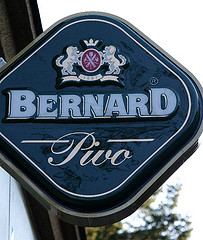 In both Nitra and Bratislava, I've spotted these signs. ("Pivo" is the Slovak word for beer.)
In both Nitra and Bratislava, I've spotted these signs. ("Pivo" is the Slovak word for beer.)It's impossible for me to pass them without thinking, "What's your favorite word? What's your least favorite word? What sound or noise inspires you? What sound or noise do you hate?" and so forth.
But no one gets the joke. Bernard Pivot, pronounced exactly the same way as this brand of beverage, is a French journalist
 (and spelling-contest creator, and the eventual host of "Bullion de Culture"). Theatre kids or avid Bravo watchers might recognize the name from Inside the Actors' Studio, where James Lipton uses his 10-question interview to wrap each episode.
(and spelling-contest creator, and the eventual host of "Bullion de Culture"). Theatre kids or avid Bravo watchers might recognize the name from Inside the Actors' Studio, where James Lipton uses his 10-question interview to wrap each episode.This being Europe, I thought the name might be deliberate wordplay. After all, France isn't so far from here, and it could be an international company. But thus far, no one I've asked has heard of Pivot the journalist, or Bernard the beer. Oh well. Jon called me a nerd when I asked him about it. I suppose he's right.
Silly Putty, on the other hand, is something known to ALL Slovaks. Right now, it's something of a craze. But the not-quite-solid, not-quite-liquid substance has grown, in its old age, from silly to intellectual - the stuff has undergone technological advances since its invention in 1950, and has taken a new name to match.
 "Thinking Putty," a great gob of clay comparable to Nickelodeon's GAK, is apparently popular in places ranging from the preschool classroom to the executive boardroom. It's used as a stress-reliever, in much the same way Americans will have those bulbous pink rubber heads, with squishy ears and convex eyes, to poke and prod at their desks.
"Thinking Putty," a great gob of clay comparable to Nickelodeon's GAK, is apparently popular in places ranging from the preschool classroom to the executive boardroom. It's used as a stress-reliever, in much the same way Americans will have those bulbous pink rubber heads, with squishy ears and convex eyes, to poke and prod at their desks.I came into the department last week to find my handler, Dusan, ordering a new supply of metallic putties from the web site. And if that's not spiffy enough, there's always the magnetic variety, or the thermal-sensitive color changing kind.
No little plastic egg, though. And don't expect to find this at ordinary 50-cent toy dispensers.
But I've heard it will still take the impression of newspaper comics, just like its predecessor.
Monday, October 23, 2006
Life as a Nomad
So. In the past seven days, I've taken a boat, a train, two buses, and a taxi across national borders. Which is to say, my darling nomads were visiting from New York, so adventure was a must.
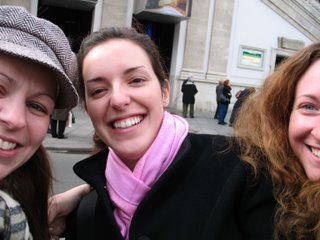
Part I: Throwing Rocks at Austria
Meg and Kristen came into Bratislava on Friday, so I took the bus from Nitra and wandered the city until they arrived. Incidentally, I met Tami and Manning, a very nice couple from Paris (by way of Philly) in a bagel shop, and after an interesting conversation about life abroad, www.hospitalityclub.org and Dracula's castle in Romania, discovered that Tami hails from Gardiner. So the inevitable conversation followed, and as it turns out, she grew up on the other side of the sky diving ranch. Small world.
When Meg's flight came in from New York, and Kristen's came in from Rome, we convened at the hotel for a while, flipped through guidebooks (though our company isn't exactly the tourist type) and decided on Indian food for dinner. Slovak Indian food, as it turns out, is quite tasty.
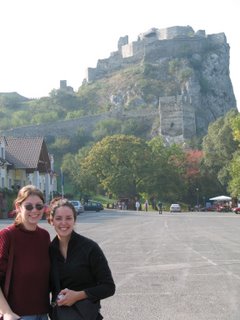 The next morning, we hopped a bus to Devin Castle, 30 minutes outside Bratislava, to play amid the ruins. The castle is located across the river from Austria - if the water were warmer, we could have swam across without a problem. As it was, a strong throw would land a rock across national borders.
The next morning, we hopped a bus to Devin Castle, 30 minutes outside Bratislava, to play amid the ruins. The castle is located across the river from Austria - if the water were warmer, we could have swam across without a problem. As it was, a strong throw would land a rock across national borders.
And if it's that easy for a rock to land in Austria....what about the three of us?
"Viennese coffee is supposed to be wonderful," Meg said. "So let's go to Austria for a cup of coffee. You know, because we can."
Our first plan was to take a boat, because the river had inspired us and boats are neat. The necessary boat, however, was sold out for the day. So we began making elaborate schemes: We'd return to Nitra for the night, head back to Bratislava on Sunday morning, go to Vienna, and then come back on Sunday evening.
Complicated? Yes. Simpler alternative? Go to Vienna by bus, and take a boat for the return journey. Which is exactly what we did.
Vienna is home to astonishing architecture, all of it massive in scope and detail. We'd taken a subway from the bus station into town, and the first thing we saw as we emerged from underground was the enormous cathedral. Our initial tour of the city, on Saturday night, led us through the Ped Zone of the Old Town, all aglow with snazzy lighting and street performers. A Picasso exhibit happened to be passing through, so we spent Sunday morning in the gallery, looking at hundreds of colorful paintings from his last decade's work.
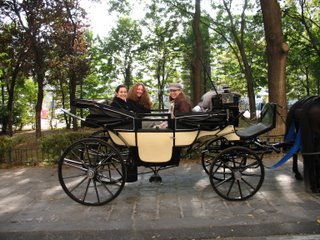
We then get a horse-and-buggy tour of town. The horses,
we noticed, wore either ear-tassles or leg-warmers. Ours were very cute and enjoyed nuzzling each other. And the tour of the city was lovely - we passed through the old town, in front of a carnival which had set up just outside of the gigantic state building, and the flower garden, where rumor has it someone actually is painting the roses red.
The three of us were scoping possibilities for lunch (This street vendor? That street vendor? What the hell is "curry-wurst"?) on the outskirts of town, waiting for our boat to dock, when we ran into fellow Fulbrighters Chuck and Susan. They had taken the same trip, more or less, arriving on Saturday by train.
Part II: 48 Hours in Slovakia
Got back to Slovakia, had another fabulous round of hot chocolate at that very evil cafe, and caught the bus to Nitra. Showed them the flat, the old town, pointed out the castle and the river. Had minor adventures in public transport, including a cab driver who swore Meg was Russian.
Not much happened here - I had class again on Monday, and Kristen and Meg had to return to Bratislava for their work meetings. K came to school with me on Monday morning, before her bus, and sat in on one of the quieter classes.
Part III: Getting to Poland - Easier Said than Done
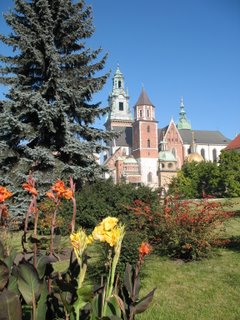 The plan was to meet at the train station on Tuesday for a 14:45 train to Krakow, with stops in one Slovak town, one Czech town, and one Polish town. That should have told us things would go awry.
The plan was to meet at the train station on Tuesday for a 14:45 train to Krakow, with stops in one Slovak town, one Czech town, and one Polish town. That should have told us things would go awry.
It's just me and Kristen at this point; Meg's taken a plane from Bratislava to Poland earlier in the day. She has her Europass East and a little syllabus with it; I have an official ticket from the train station. Things are going smoothly, we're enjoying the countryside landscapes, and then suddenly we're stranded in Nowheresville, Czech Republic, a town with no connecting trains and no bus station.
The information desk tells us that the train we were supposed to take left 3 hours ago. Splendid. It's 18:15. The next train is at 1:00. Also splendid. And our cell phones, as we've only now discovered, don't work at all in foreign countries.
Aaaaand this is the adventure that no foreign travel is complete without. We have five hours before any possibility of Poland, and then another five hours on the train to get there.
We decide, for lack of better things to do, that we should explore this quaint Eastern European town. And then I see it: a row of yellow-topped taxis. I start laughing.
"Hey Kristen? How crazy would it be if we took a taxi to Krakow?"
We asked the driver for an estimate, which was surprisingly reasonable, given the 5-hour journey ahead of us. (Also, Kristen had work meetings in the morning, and getting in at 6 am after a series of connecting trains which may or may not have existed didn't sound like the best plan). So we grab our stuff, duck into a bankomat, and head for Poland in a Skoda with a driver who may easily never have been there before.
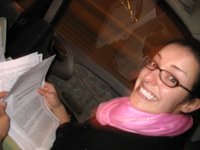 That last statement doesn't dawn on us until the cab starts pulling over to ask pedestrians (of which there were many, fortunately) "Which way to Krakow?" At this point, we're sure we're going to end up in Minsk. The driver does this a few times, turns around a few times, and stops for a hitchhiker near the Polish border (who was not heading in our direction, but rather for the pub). And eventually, we make it to our hotel. Never mind the castle on a cliff above us, we were very happy to have made it intact and only slightly behind schedule.
That last statement doesn't dawn on us until the cab starts pulling over to ask pedestrians (of which there were many, fortunately) "Which way to Krakow?" At this point, we're sure we're going to end up in Minsk. The driver does this a few times, turns around a few times, and stops for a hitchhiker near the Polish border (who was not heading in our direction, but rather for the pub). And eventually, we make it to our hotel. Never mind the castle on a cliff above us, we were very happy to have made it intact and only slightly behind schedule.
"You're late," was our greeting from M. "We did a silly thing...." we replied.
Part IV: Poets, Castles, and Airports
Krakow was my favorite of the cities on our rockstar tour of Central/Eastern Europe, though all of them were magnificent. Didn't find any Jancowfskis (would have been my grandfather's relatives), but we did have coffee with a brillant poet and lovely person, Adam Z.
 And we did the castle, because castles had become something of a motif in our travels thus far. It's an intellectual city, so there's not as much commerical salesy stuff as in, say, Vienna.
And we did the castle, because castles had become something of a motif in our travels thus far. It's an intellectual city, so there's not as much commerical salesy stuff as in, say, Vienna.
Instead, you have street musicians, art vendors, a giant severed head (?), and the central market, where you can buy handmade chess sets and inexpensive Baltic amber.
There's also, apparently, a Middle Earth pub. (I thought of my P2 ladies and took a picture.) Didn't go in, but liked the fact that Tolkein has a presence in Krakow. (I knew I liked this city for a reason!) We dined one night in a place that looked like Medieval Times – The Polish Installment, where everyone was in costume and we felt rather out of place for not having slain a dragon or worn our corsets. We didn't go to Auschwitz - too bleak for short time in the country, and we didn't have enough free slots in our days to travel there anyhow - but tried to go to the salt mines, which were supposed to be incredible. Didn't make it there either, but it's good to save something for next time.
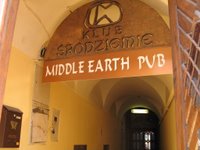
So, on Thursday night, with my friends slated to leave for Prague the next morning, I still hadn't booked a trip home. Trains were seeming more and more dubious, except for the Eurail express which cost as much as a plane ticket to Prague. That decided it. Prague won. I'd catch a bus from Prague to BA on Saturday morning and make it back to Nitra in time for Betsy and Mark's gathering that night.
Part V: Czech Us Out
And then we're in Prague! M and K had more meetings that morning, so we dropped our things off at the hotel, they scurried off to their work things, and I headed down the hill toward the Charles Bridge.
 Prague is characterized by terra-cotta roofs, struedel stands, sloping hill sidewalks, and a stunning landscape. (Also blacklight theatre and marionettes, for some unknown reason - they were doing Don Giovanni and CATS while we were there. Yes, like a little muppetty rave. We didn't go.)
Prague is characterized by terra-cotta roofs, struedel stands, sloping hill sidewalks, and a stunning landscape. (Also blacklight theatre and marionettes, for some unknown reason - they were doing Don Giovanni and CATS while we were there. Yes, like a little muppetty rave. We didn't go.)
The bridge is the main location for artisans and their wares, but as I walked across, it was early enough that many were just setting up their stands. A descent into old town led me to another castle and cathedral, but I didn't really explore those until later.
We met for lunch, on a mission for dumplings. And dumplings we found – in a little place decorated with bizarre murals and metal hands on sticks. I ordered something vegetarian, in fact the only vegetarian dumpling, which turned out to be potato and Bisquick exterior with hot plum and fig centres, smothered in whipped cream and chocolate syrup. (Note: Did not order this off the dessert menu!)
 And then the girls were off to another meeting, which meant I went down the hill again to play in Prague. Met again in an hour. K locked herself in the hotel room to finish a paper; M and I went sightseeing. We saw the castle’s main square, as well as the Astronomical Clock (quite funny to be there on the hour, when the cobblestone path outside the clock fills with people craning their necks upward, positioning cameras for the display when the hour strikes).
And then the girls were off to another meeting, which meant I went down the hill again to play in Prague. Met again in an hour. K locked herself in the hotel room to finish a paper; M and I went sightseeing. We saw the castle’s main square, as well as the Astronomical Clock (quite funny to be there on the hour, when the cobblestone path outside the clock fills with people craning their necks upward, positioning cameras for the display when the hour strikes).
After a brief snack interlude – street vendors this time, much better than our lunch – we headed for the Jewish quarter, which was very spiffy and rather haunting. Because it didn’t occur to us that it was nearing sundown on a Friday (and thus, everything would close), we went into the ticket office and gift shop to try to get into one of the museums. That didn’t happen, but I spotted the charm – something like a hand, with Hebrew embossed on its palm, and all fingers connecting to those adjacent – that my grandmother always wore around her neck. I never knew it was a Jewish thing. When asked, the sales clerk told me it was a symbol of good luck.
 We did dinner at a place that let us sign the walls, and so K designed a heiroglyph with our initials and the Gucci Nomad tag. A fitting way to end the trip.
We did dinner at a place that let us sign the walls, and so K designed a heiroglyph with our initials and the Gucci Nomad tag. A fitting way to end the trip.
But that’s not all! The next morning, while K was asleep, M and I went to the Museum of Communism before I had to be at the bus station. (All of Prague is littered with billboards with the image of a nesting doll with fangs, and this museum’s logo.)
The place, I should mention, is ironically nestled between a McDonalds and a casino. The museum was neat, if not eerie, and we emerged with – no joke – communist underwear sets.
Getting back was another adventure, as the bus I wanted to take was sold out. As was the next bus, and the next bus. So all hope of getting back to Nitra for Mark and Betsy’s party was quickly diminishing, and I had no way of calling them to let them know. (Again - sorry guys!)
Finally, at 16:30, there was a bus to Bratislava available, then an hour later one to Nitra. And so the wonderful journey came to a close, I returned to my flat, and now life goes on as usual in the wake of our absurd international adventures.

Part I: Throwing Rocks at Austria
Meg and Kristen came into Bratislava on Friday, so I took the bus from Nitra and wandered the city until they arrived. Incidentally, I met Tami and Manning, a very nice couple from Paris (by way of Philly) in a bagel shop, and after an interesting conversation about life abroad, www.hospitalityclub.org and Dracula's castle in Romania, discovered that Tami hails from Gardiner. So the inevitable conversation followed, and as it turns out, she grew up on the other side of the sky diving ranch. Small world.
When Meg's flight came in from New York, and Kristen's came in from Rome, we convened at the hotel for a while, flipped through guidebooks (though our company isn't exactly the tourist type) and decided on Indian food for dinner. Slovak Indian food, as it turns out, is quite tasty.
 The next morning, we hopped a bus to Devin Castle, 30 minutes outside Bratislava, to play amid the ruins. The castle is located across the river from Austria - if the water were warmer, we could have swam across without a problem. As it was, a strong throw would land a rock across national borders.
The next morning, we hopped a bus to Devin Castle, 30 minutes outside Bratislava, to play amid the ruins. The castle is located across the river from Austria - if the water were warmer, we could have swam across without a problem. As it was, a strong throw would land a rock across national borders. And if it's that easy for a rock to land in Austria....what about the three of us?
"Viennese coffee is supposed to be wonderful," Meg said. "So let's go to Austria for a cup of coffee. You know, because we can."
Our first plan was to take a boat, because the river had inspired us and boats are neat. The necessary boat, however, was sold out for the day. So we began making elaborate schemes: We'd return to Nitra for the night, head back to Bratislava on Sunday morning, go to Vienna, and then come back on Sunday evening.
Complicated? Yes. Simpler alternative? Go to Vienna by bus, and take a boat for the return journey. Which is exactly what we did.
Vienna is home to astonishing architecture, all of it massive in scope and detail. We'd taken a subway from the bus station into town, and the first thing we saw as we emerged from underground was the enormous cathedral. Our initial tour of the city, on Saturday night, led us through the Ped Zone of the Old Town, all aglow with snazzy lighting and street performers. A Picasso exhibit happened to be passing through, so we spent Sunday morning in the gallery, looking at hundreds of colorful paintings from his last decade's work.

We then get a horse-and-buggy tour of town. The horses,
we noticed, wore either ear-tassles or leg-warmers. Ours were very cute and enjoyed nuzzling each other. And the tour of the city was lovely - we passed through the old town, in front of a carnival which had set up just outside of the gigantic state building, and the flower garden, where rumor has it someone actually is painting the roses red.
The three of us were scoping possibilities for lunch (This street vendor? That street vendor? What the hell is "curry-wurst"?) on the outskirts of town, waiting for our boat to dock, when we ran into fellow Fulbrighters Chuck and Susan. They had taken the same trip, more or less, arriving on Saturday by train.
Part II: 48 Hours in Slovakia
Got back to Slovakia, had another fabulous round of hot chocolate at that very evil cafe, and caught the bus to Nitra. Showed them the flat, the old town, pointed out the castle and the river. Had minor adventures in public transport, including a cab driver who swore Meg was Russian.
Not much happened here - I had class again on Monday, and Kristen and Meg had to return to Bratislava for their work meetings. K came to school with me on Monday morning, before her bus, and sat in on one of the quieter classes.
Part III: Getting to Poland - Easier Said than Done
 The plan was to meet at the train station on Tuesday for a 14:45 train to Krakow, with stops in one Slovak town, one Czech town, and one Polish town. That should have told us things would go awry.
The plan was to meet at the train station on Tuesday for a 14:45 train to Krakow, with stops in one Slovak town, one Czech town, and one Polish town. That should have told us things would go awry. It's just me and Kristen at this point; Meg's taken a plane from Bratislava to Poland earlier in the day. She has her Europass East and a little syllabus with it; I have an official ticket from the train station. Things are going smoothly, we're enjoying the countryside landscapes, and then suddenly we're stranded in Nowheresville, Czech Republic, a town with no connecting trains and no bus station.
The information desk tells us that the train we were supposed to take left 3 hours ago. Splendid. It's 18:15. The next train is at 1:00. Also splendid. And our cell phones, as we've only now discovered, don't work at all in foreign countries.
Aaaaand this is the adventure that no foreign travel is complete without. We have five hours before any possibility of Poland, and then another five hours on the train to get there.
We decide, for lack of better things to do, that we should explore this quaint Eastern European town. And then I see it: a row of yellow-topped taxis. I start laughing.
"Hey Kristen? How crazy would it be if we took a taxi to Krakow?"
We asked the driver for an estimate, which was surprisingly reasonable, given the 5-hour journey ahead of us. (Also, Kristen had work meetings in the morning, and getting in at 6 am after a series of connecting trains which may or may not have existed didn't sound like the best plan). So we grab our stuff, duck into a bankomat, and head for Poland in a Skoda with a driver who may easily never have been there before.
 That last statement doesn't dawn on us until the cab starts pulling over to ask pedestrians (of which there were many, fortunately) "Which way to Krakow?" At this point, we're sure we're going to end up in Minsk. The driver does this a few times, turns around a few times, and stops for a hitchhiker near the Polish border (who was not heading in our direction, but rather for the pub). And eventually, we make it to our hotel. Never mind the castle on a cliff above us, we were very happy to have made it intact and only slightly behind schedule.
That last statement doesn't dawn on us until the cab starts pulling over to ask pedestrians (of which there were many, fortunately) "Which way to Krakow?" At this point, we're sure we're going to end up in Minsk. The driver does this a few times, turns around a few times, and stops for a hitchhiker near the Polish border (who was not heading in our direction, but rather for the pub). And eventually, we make it to our hotel. Never mind the castle on a cliff above us, we were very happy to have made it intact and only slightly behind schedule. "You're late," was our greeting from M. "We did a silly thing...." we replied.
Part IV: Poets, Castles, and Airports
Krakow was my favorite of the cities on our rockstar tour of Central/Eastern Europe, though all of them were magnificent. Didn't find any Jancowfskis (would have been my grandfather's relatives), but we did have coffee with a brillant poet and lovely person, Adam Z.
 And we did the castle, because castles had become something of a motif in our travels thus far. It's an intellectual city, so there's not as much commerical salesy stuff as in, say, Vienna.
And we did the castle, because castles had become something of a motif in our travels thus far. It's an intellectual city, so there's not as much commerical salesy stuff as in, say, Vienna.Instead, you have street musicians, art vendors, a giant severed head (?), and the central market, where you can buy handmade chess sets and inexpensive Baltic amber.
There's also, apparently, a Middle Earth pub. (I thought of my P2 ladies and took a picture.) Didn't go in, but liked the fact that Tolkein has a presence in Krakow. (I knew I liked this city for a reason!) We dined one night in a place that looked like Medieval Times – The Polish Installment, where everyone was in costume and we felt rather out of place for not having slain a dragon or worn our corsets. We didn't go to Auschwitz - too bleak for short time in the country, and we didn't have enough free slots in our days to travel there anyhow - but tried to go to the salt mines, which were supposed to be incredible. Didn't make it there either, but it's good to save something for next time.

So, on Thursday night, with my friends slated to leave for Prague the next morning, I still hadn't booked a trip home. Trains were seeming more and more dubious, except for the Eurail express which cost as much as a plane ticket to Prague. That decided it. Prague won. I'd catch a bus from Prague to BA on Saturday morning and make it back to Nitra in time for Betsy and Mark's gathering that night.
Part V: Czech Us Out
And then we're in Prague! M and K had more meetings that morning, so we dropped our things off at the hotel, they scurried off to their work things, and I headed down the hill toward the Charles Bridge.
 Prague is characterized by terra-cotta roofs, struedel stands, sloping hill sidewalks, and a stunning landscape. (Also blacklight theatre and marionettes, for some unknown reason - they were doing Don Giovanni and CATS while we were there. Yes, like a little muppetty rave. We didn't go.)
Prague is characterized by terra-cotta roofs, struedel stands, sloping hill sidewalks, and a stunning landscape. (Also blacklight theatre and marionettes, for some unknown reason - they were doing Don Giovanni and CATS while we were there. Yes, like a little muppetty rave. We didn't go.)The bridge is the main location for artisans and their wares, but as I walked across, it was early enough that many were just setting up their stands. A descent into old town led me to another castle and cathedral, but I didn't really explore those until later.
We met for lunch, on a mission for dumplings. And dumplings we found – in a little place decorated with bizarre murals and metal hands on sticks. I ordered something vegetarian, in fact the only vegetarian dumpling, which turned out to be potato and Bisquick exterior with hot plum and fig centres, smothered in whipped cream and chocolate syrup. (Note: Did not order this off the dessert menu!)
 And then the girls were off to another meeting, which meant I went down the hill again to play in Prague. Met again in an hour. K locked herself in the hotel room to finish a paper; M and I went sightseeing. We saw the castle’s main square, as well as the Astronomical Clock (quite funny to be there on the hour, when the cobblestone path outside the clock fills with people craning their necks upward, positioning cameras for the display when the hour strikes).
And then the girls were off to another meeting, which meant I went down the hill again to play in Prague. Met again in an hour. K locked herself in the hotel room to finish a paper; M and I went sightseeing. We saw the castle’s main square, as well as the Astronomical Clock (quite funny to be there on the hour, when the cobblestone path outside the clock fills with people craning their necks upward, positioning cameras for the display when the hour strikes).After a brief snack interlude – street vendors this time, much better than our lunch – we headed for the Jewish quarter, which was very spiffy and rather haunting. Because it didn’t occur to us that it was nearing sundown on a Friday (and thus, everything would close), we went into the ticket office and gift shop to try to get into one of the museums. That didn’t happen, but I spotted the charm – something like a hand, with Hebrew embossed on its palm, and all fingers connecting to those adjacent – that my grandmother always wore around her neck. I never knew it was a Jewish thing. When asked, the sales clerk told me it was a symbol of good luck.
 We did dinner at a place that let us sign the walls, and so K designed a heiroglyph with our initials and the Gucci Nomad tag. A fitting way to end the trip.
We did dinner at a place that let us sign the walls, and so K designed a heiroglyph with our initials and the Gucci Nomad tag. A fitting way to end the trip. But that’s not all! The next morning, while K was asleep, M and I went to the Museum of Communism before I had to be at the bus station. (All of Prague is littered with billboards with the image of a nesting doll with fangs, and this museum’s logo.)
The place, I should mention, is ironically nestled between a McDonalds and a casino. The museum was neat, if not eerie, and we emerged with – no joke – communist underwear sets.
Getting back was another adventure, as the bus I wanted to take was sold out. As was the next bus, and the next bus. So all hope of getting back to Nitra for Mark and Betsy’s party was quickly diminishing, and I had no way of calling them to let them know. (Again - sorry guys!)
Finally, at 16:30, there was a bus to Bratislava available, then an hour later one to Nitra. And so the wonderful journey came to a close, I returned to my flat, and now life goes on as usual in the wake of our absurd international adventures.
Thursday, October 05, 2006
Unexpected city-dwellers
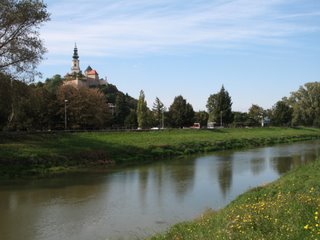
Second week teaching.
Thursdays are by far my favorite day: I have Fridays off, so Thursdays signify the end of the week. But more than that, it's become my day for exploring the city. My first and only class is Special Language Seminar at 15.45 - an amazing group of first-years - so I've been coming into the department, getting some prep work done for the following week, and then going out for walks around lunch time.
Last week, I encountered something rather interesting:
From the university, if you walk around the corner of the building toward the mountain, you will pass a small daycare, an abandoned factory marked in bright graffiti, and a lesser-known walking bridge, which takes you first over the highway, then across the Nitra River. On either side of the river are walking paths, which serve as arterials throughout the city limits. (See above, if you can't picture it.)
But I didn't take those paths. I kept walking straight, into what looked like a sizeable city park. You know, the typical imagery: a couple making out and nearly horizontal on a bench, mothers wheeling strollers, school kids with ice cream cones, and all around trees, playground apparatus, and...
A cow?

Yes. A cow was, in fact, sitting in the middle of the park. For no good reason. She had a yellow tag in one ear, and for a second I thought she might belong to the elderly chap reading a newspaper on the bench behind her. But no--when I asked the university folks what, exactly, this bovine friend was doing there, they told me:
It's so the city kids know what a cow looks like. (Of course.) I guess this was something of a problem? If this is an urban epidemic, it might just be a matter of time before Central Park gets a barn.
The alternate response to my question (because I asked several people about this) was that she was there for the kids to play with. A kind of mammalian playground. And, you know, fresh milk.
I should probably mention that these guys were hanging about, too:

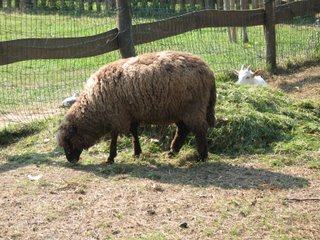
But they were in a fenced area, and the sheep had other sheep; the goats had other goats. Our poor cow was all by herself in a sea of swingsets and walking trails.
Alright, enough pontificating on furry things. Finally uploaded the SK pics. And all of this multimedia is about to wilt my feeble department computer, so I'll wrap things up for now.
